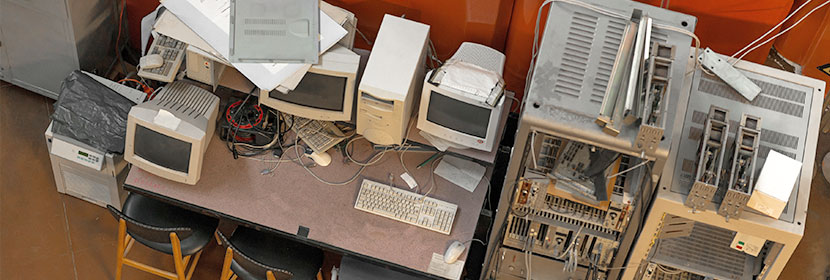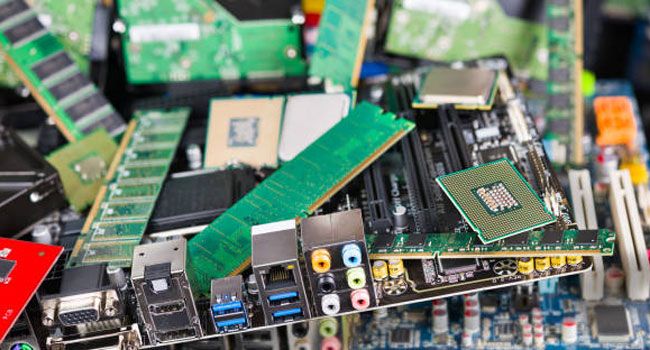IT Asset Disposal: How Should You Deal with Old IT Equipment

Used IT equipment must be disposed of responsibly. When we say that, we refer not just to the environmental footprint of used IT equipment – we also refer to data security. Your IT asset disposal (ITAD) process or IT support vendor must also include fully wiping data on the IT kit that you are disposing.
Correct IT asset disposal is essential if you want to prevent information security risks. That said, you can also enjoy some returns on your used IT if you dispose of it correctly – particularly where companies are undergoing large shifts in IT and there is a significant volume of equipment involved.
Regulations around data security

When it comes to thinking about ITAD and IT support you need to complete the process the most important aspect is data security. Whether you dispose of your equipment via a recycling facility or have the opportunity to capture some resale value, data security should be the first point of concern in your ITAD program.
Core to this is data destruction – whichever route your equipment follows to its end of life, there must be a sanitation process where you fully and completely remove any data from the equipment. For better or worse, this typically requires physical destruction: though advanced erasure techniques should wipe most data from hard drives, only physical destruction will ensure that data cannot be accessed.
That said, depending on your regulatory environment, you may be able to follow a sanitation process that leaves physical equipment intact for future users.
Environmental concerns

The second major concern is for the environment. Where your equipment is not fit for resale you will need to find a way to dispose of it responsibly. Tech kit is not suitable for disposal alongside general waste – it is as simple as that. PCs, servers, and peripherals all contain high concentrations of compounds that do not break down easily in the environment.
From a purely corporate social responsibility viewpoint you must take care to dispose of your equipment via a recycling facility that specialises in the disposal of computer hardware. Look for a recycling partner with the right certification and be prepared to pay up to recycle your kit in an environmentally friendly way.
Five steps to IT asset disposal

So, with data security and environmental concerns in mind, we suggest that companies follow these five steps to safely and responsibly dispose of used IT equipment. Companies also need to ensure that their IT support partner follows similar steps.
-
De-install and catalogue IT equipment
IT disposal often requires a certification process – in other words, when companies get rid of old IT kit it is important to account for each bit of equipment removed, as well as the process followed during removal.
Cataloguing the equipment being disposed of is therefore key as it ensures that no equipment is left outside of a certified data destruction program. Safe, secure de-installation is also important to ensure that removing redundant equipment does not unintentionally disrupt operations. As part of secure de-installation companies should also be mindful of thoroughly removing permissions and credentials.
-
Data destruction
It does not matter which route to disposal your equipment follows – recycling, destruction or resale or indeed using your IT support vendor for disposal. Data destruction is a critical aspect of your ITAD process. Note that the regulatory requirements governing data destruction varies from industry to industry – if your company handles personally sensitive data your data sanitation process will need to be far more rigorous.
Securely wiping drives so that your equipment can be resold may be just fine – but do make sure that you verify what your regulatory regime is and that you put in place steps to address sanitation requirements.
-
Refurbish equipment and reselling
Depending on the age and the condition of your used IT equipment you may find that disposing of it via resale can draw a significant return. For example, if your company frequently upgrades IT kit it may well find that the equipment being replaced has a useful resale value.
You may be able to prepare your equipment for resale in-house, but only if you’re buying and selling equipment at scale. Instead, consider using an ITAD partner willing to purchase equipment from your company at a reasonable value. This partner can in turn market and refurbish the equipment on your behalf in a more efficient manner.
-
Responsible disposal
We pointed to responsible disposal earlier in this article. E-waste is a significant problem, and your company should guard against contributing to this problem. Disposing of technology equipment via general waste facilities is simply not an option.
Instead, find and partner with a disposal facility that can ensure that your used IT equipment is processed in a way that poses minimum impact on the environment – and which does not put your company in breach of regulatory compliance.
-
Reporting and certification
Finally, when you dispose of your technology assets you need to ensure that you document it correctly. This matters because your stakeholders – and regulators – may well require that you are able to prove that you have disposed of your technology assets in a responsible manner.
Indeed, it may be worth looking into official certification from an approved body. In other words, get in touch with an ITAD partner that certify your IT disposal process so that you have solid proof in case any questions ever arrive.
Related Posts
By accepting you will be accessing a service provided by a third-party external to https://www.htl.london/